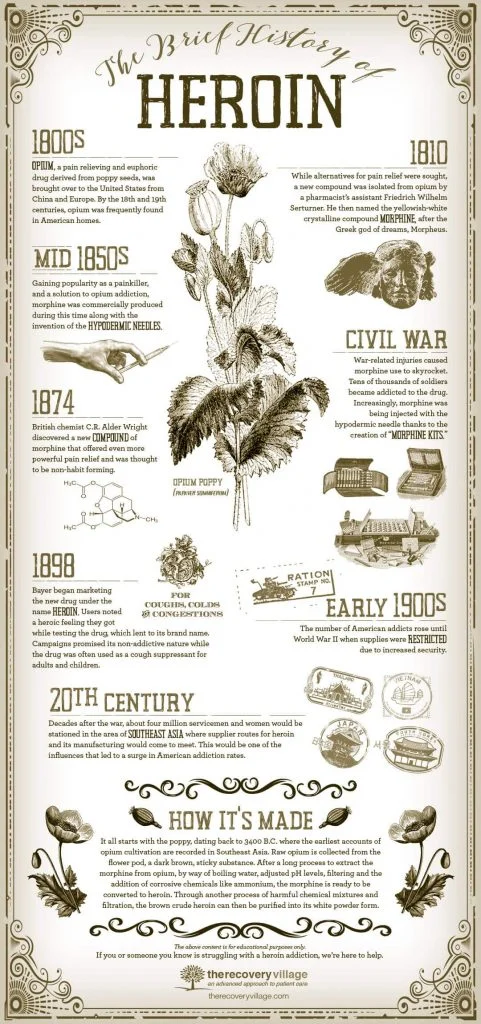An overview of the heroin history timeline and heroin addiction history.
Heroin is one of the most damaging and also notorious illegal drugs in the United States. The U.S. is currently in the midst of a staggering opioid epidemic, and heroin is front and center in that.
Heroin isan illegaldrug responsiblefor countless deaths and immense destruction to families and even entire communities.
When heroin is used, it binds to opioid receptors throughout the central nervous system, and it has a pain-relieving effect. It can initially create a sense of euphoria and well-being. Following the high of heroin, people often feel drowsy and sluggish, and they may nod off or appear visibly impaired. Heroin is highly addictive and physical dependence on tends to develop quickly. Withdrawal from the drug is often difficult.
Despite the fact that heroin is so relevant in the opioid epidemic, a lot of people don’t know very much about the history of the drug.
The following is an overview of the heroin history timeline and heroin addiction history.
Heroin History Timeline
Heroin is derived from morphine and opium, and while heroin itself has a history only dating back to around 1874, morphine and opium have a much longer history in the world.
For example, opium was discovered in the Mediterranean mountains sometime between 10,200 B.C. and 2,000 B.C. Following its discovery, the use of opium spread throughout the world. In Europe, opium and then morphine began to be used in medicine for hundreds of years.
The discovery of heroin itself was credited to C.R. Wright in England in 1874. Wright boiled morphine and acetic anhydride to create the first version of synthesized heroin. The early iterations of heroin had side effects that were seen as negative including anxiety and vomiting, so Wright ended his research. It wasn’t until 1895 that a German scientist by the name of Heinrich Dreser, who worked for the Bayer company, started looking at it again as a way to treat respiratory diseases.
The Bayer pharmaceutical company started making diacetylmorphine, and its marketing name was heroin. At this point, heroin was available over-the-counter.
Heroin was viewed as a cure-all for everything from headaches to the common cold. Many of the people who used heroin were wealthy people. At the time, heroin was viewed as a safe alternative to morphine because it was seen as less addictive. People who were addicted to morphine, as well as codeine, were given heroin as a way to treat their addiction.
Heroin Addiction History
By the mid-1800s, opium had become extremely popular, with opium dens located around the world, including in the United States. Opium dens were prevalent in the “wild west,” largely because Chinese immigrants brought it with them when they came to work on the railroads.
Around the 1850s, morphine became available in the U.S. and its use was popular in medicine. Morphine was used to treat pain, and during the Civil War, it was one of the primary treatment options for injured soldiers. During this time, doctors were amazed at morphine’s ability to help with even severe pain. However, following the Civil War, it started to become clear that morphine had a serious side effect: addiction.
Following the Civil War, there were tens of thousands of soldiers from both sides that were addicted to morphine. Morphine addiction became an epidemic in the U.S. just a short time after it was introduced in the country. Doctors were concerned and searched for ways to deal with the problem, and that’s why the introduction of heroin in Germany became interesting to physicians in the U.S.
After the German invention of heroin, it was imported to the U.S. and the sales pitch for it was that it was a safe and non-addictive alternative to morphine. Shortly after, it became apparent that heroin was also extremely addictive.
History of Heroin in the U.S.
The history of heroin in the U.S. began in the late 1800s, and by the early 1900s, the drug was available over-the-counter as it was in Germany. There were even kits sold that included hypodermic needles and vials of opiates. Advertising and marketing campaigns touted heroin as a remedy for most ailments.
It wasn’t until the 1920s that regulation was introduced for the sale of heroin and other opiates. The Dangerous Drug Act was introduced and made into law by Congress, and it regulated the sale of heroin and other opiates. The medications were no longer available over-the-counter.
Despite this attempt to curb addiction, there were around 200,000 people that had already developed heroin use disorders in the United States.
There have been waves of additional heroin crises throughout the years, including in the 1970s.
While it’s been more than a century since the original crackdown on heroin, America is still in an opioid crisis. It’s been declared a national emergency.
If you or a loved one live with addiction or are using drugs recreationally and want to stop, The Recovery Village® can help.Reach outto one of our representatives today to learn how you can start on your path to recovery.





